| Pages:
1
2
3
4
..
6 |
Magpie
lab constructor
    
Posts: 5939
Registered: 1-11-2003
Location: USA
Member Is Offline
Mood: Chemistry: the subtle science.
|
|
Here's some recollections from my lab experience, FYI:
1. A porous catalyst support can be made from landscaping lava rock. I made some 4-8 mesh as a support for H3PO4 catalyst. It's extremely hard,
however, and difficult to reduce to the desired particle size.
Pumice is available as an abrasive at pool supply stores. This might make a good catalyst support.
2. I made anhydrous NH3 by boiling it out of a water solution then passing it through a column loaded with KOH flakes.
The single most important condition for a successful synthesis is good mixing - Nicodem
|
|
|
Chemetix
Hazard to Others
  
Posts: 375
Registered: 23-9-2016
Location: Oztrayleeyah
Member Is Offline
Mood: Wavering between lucidity and madness
|
|
What I have learnt from this build is the ammonia oxidation reaction is a robust one. It doesn't need a finely tuned set of operating parameters. And
there are probably dozens of suitable catalysts out there, I had a few lined up to test and it turned out cobalt was active enough and so I stuck with
it. Nickle oxide was my next bet.
The support bed can be just about anything- dirt! The catalyst doesn't seem to care what it's on so long as it holds up at the temperatures and gives
you enough support, but volcanic rock or pumice (also a volcanic rock) would be perfect. I was looking to smash up and grind a piece of kiln
furniture, and I did try breaking a fire brick but got more dust than screenings.
The tube - how many other options are there?
I'd say the reaction can be lowered to 500C, which is borosilicate range of working temps, just pack more catalyst into a longer tube to allow for the
slower rate of reaction. I have eyed off a piece of tubing used for thermocouples, a pyro-ceramic of some sorts. A suitable alternative would be
something like a copper tube with some glass tape wound around it( automotive exhaust shop), make a paint with sodium silicate and some silica
flour(inhalation hazard) from a ceramics supply. Then some nichrome wire around that and more insulation over the top.
I'd say if you get fairly anhydrous NH3 without the CO2 at an optimum air mix, the reaction might just self sustain the heating. Nickle oxide I
strongly suspect to be more active than the cobalt, but that's a hunch at this stage.
[Edited on 25-12-2016 by Chemetix]
|
|
|
Chemetix
Hazard to Others
  
Posts: 375
Registered: 23-9-2016
Location: Oztrayleeyah
Member Is Offline
Mood: Wavering between lucidity and madness
|
|
Sorry I forgot to answer that; 8mm ID.
|
|
|
Chemetix
Hazard to Others
  
Posts: 375
Registered: 23-9-2016
Location: Oztrayleeyah
Member Is Offline
Mood: Wavering between lucidity and madness
|
|
[Edited on 26-12-2016 by Chemetix]
|
|
|
Magpie
lab constructor
    
Posts: 5939
Registered: 1-11-2003
Location: USA
Member Is Offline
Mood: Chemistry: the subtle science.
|
|
I'm a little confused here: are you admitting air into the 2L sep funnel absorber as well as ahead of the reactor?
Quote: Originally posted by Chemetix  |
This shot shows where the ammonia air mixture is fed into the reaction zone, the nice red glow is transmitted up the quartz.
|
Clearly you are admitting air here ahead of the reactor. I assume this is the slightly pressurized source from the compressor?
The single most important condition for a successful synthesis is good mixing - Nicodem
|
|
|
Chemetix
Hazard to Others
  
Posts: 375
Registered: 23-9-2016
Location: Oztrayleeyah
Member Is Offline
Mood: Wavering between lucidity and madness
|
|
Yes I can add air ahead of the reactor, in fact you need to:
4NH3 +5 O2 => 2NO + 3H2O
In the sep funnel the reaction:
2NO+ O2 => 2NO2
means you should need to add air as well. The ammonia air mixture was quite oxygen rich and so the unreacted O2 formed the needed O2 in the sep
funnel. This meant I was only diluting the reaction with more air and slowing the next reaction down
2NO2 => N2O4
The rate of dimerization is proportional to concentration.
So I turned off the secondary air inlet and noticed the colour became darker. Edit- sorry, that makes it sound like the N2O4 is the darker product...
it's just there was more NO2 by volume and hence darker.
[Edited on 26-12-2016 by Chemetix]
[Edited on 26-12-2016 by Chemetix]
|
|
|
phlogiston
International Hazard
    
Posts: 1379
Registered: 26-4-2008
Location: Neon Thorium Erbium Lanthanum Neodymium Sulphur
Member Is Offline
Mood: pyrophoric
|
|
Do you have any idea if some of the ammonia is able to pass the reactor unreacted? That would result in acid containing dissolved ammonia nitrate.
-----
"If a rocket goes up, who cares where it comes down, that's not my concern said Wernher von Braun" - Tom Lehrer |
|
|
Chemetix
Hazard to Others
  
Posts: 375
Registered: 23-9-2016
Location: Oztrayleeyah
Member Is Offline
Mood: Wavering between lucidity and madness
|
|
New Catalyst
Quote: Originally posted by phlogiston  | | Do you have any idea if some of the ammonia is able to pass the reactor unreacted? That would result in acid containing dissolved ammonia nitrate.
|
In the preliminary trials I did with the catalyst on glass fiber, the support melted and there was little surface area to react with and ammonia
started coming over past the reaction zone. White fumes appeared as the acid and base began to react.
This happened again today as I had made some modifications to the set up.
I dried the ammonia/air mixture with a reflux condenser this time and noticed there was more glow coming from the reactor and then things started to
change. The oxidation chamber lost colour and there was no condensation forming. I lifted the condenser coil out and whiffed the emanating fumes
lightly - ammonia. The catalyst had died.
I shut everything down and cleaned out the reactor; the support had a slightly glazed look and a greyish colour. There was oxide residue on the walls
and I used some conc. HCL to remove it. What was telling and confusing was the smell of sulfide. Sulfur had killed the catalyst but where did it come
from? It gave me the chance to try another variation I had in mind.
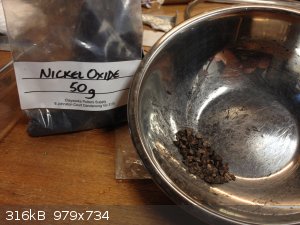
Broken bath tile support and nickle oxide.
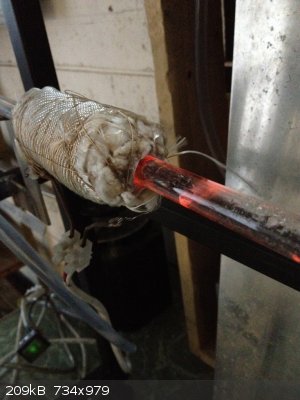
Not only did the NiO work, it worked well. The reaction zone glowed much hotter and pulsed hotter with the higher flow rates from the air/ ammonia
generator. I'd bet that this would self sustain once it has got to this temperature. Will try next run.
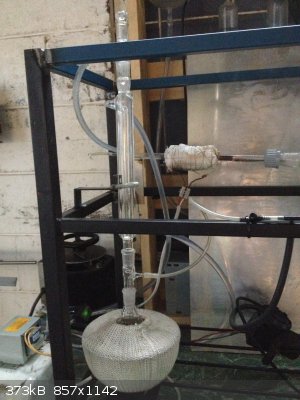
This is the condenser to dry the ammonia/air stream.
The pulsing glow happens due to the concentrated ammonia solution in the condenser falling back into the flask as drops, the cold concentrated
solution emits gas as it hits the hot solution of urea.
The dried air/ammonia "burns" hotter than with the water rich vapour I was using. 1- it meant the high temperatures could have caused contaminants in
the expanded clay balls to react with the catalyst or fuse with the catalyst, killing it.
2- it makes more concentrated acid without the introduction of water into the stream.
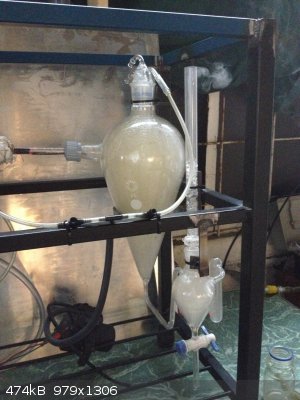
Concentrated nitric fumes like crazy in moist air. The oxidation chamber was filled with acid mist this time. Concentrated acid fumes can be seen
leaving the absorption tower. I now understand the need for multiple towers used in industry.
I ran out of time to titrate the product, but it took more Bi-Carb to neutralise a similar quantity of the last batch, and the tower solution gave a
more pronounced reaction with bicarb despite far less operating time.
[Edited on 27-12-2016 by Chemetix]
|
|
|
Jstuyfzand
Hazard to Others
  
Posts: 166
Registered: 16-1-2016
Location: Netherlands
Member Is Offline
Mood: Learning, Sorta.
|
|
POTENTIAL!
Looking great Chemetix, great work!
Have you tried MnO2 as the catalyst?
|
|
|
Fulmen
International Hazard
    
Posts: 1716
Registered: 24-9-2005
Member Is Offline
Mood: Bored
|
|
Outstanding work, truly inspiring. Cobalt seems to be the ideal catalyst for this, from what I can tell it's in commercial use today. And a heck of a
lot easier to get hold off than platinum/rhodium. If nickel was anywhere near this good, wouldn't we've heard about it by now?
Anyway, the biggest challenge as I see it is the ammonia-generation. I like your approach, but I still can't help thinking there's a better one out
there. A kipp-style generator would be perfect, but that's not as easy as it sounds.
I'm not big on glassware, but I wonder if it isn't possible to construct a compact design from metal, at least the ammonia and reaction zones.
We're not banging rocks together here. We know how to put a man back together.
|
|
|
j_sum1
Administrator
       
Posts: 6322
Registered: 4-10-2014
Location: At home
Member Is Offline
Mood: Most of the ducks are in a row
|
|
My standard ammonia generator is NaOH drain cleaner and ammonium sulfate fertiliser. Neither is too expensive. I don't see why a different ammonia
feed would be problematic.
|
|
|
Chemetix
Hazard to Others
  
Posts: 375
Registered: 23-9-2016
Location: Oztrayleeyah
Member Is Offline
Mood: Wavering between lucidity and madness
|
|
Quote: Originally posted by Fulmen  | If nickel was anywhere near this good, wouldn't we've heard about it by now?
.... but I wonder if it isn't possible to construct a compact design from metal, at least the ammonia and reaction zones. |
It's funny, I've sort of made a career out of doing things that are assumed to be obvious to everyone else as either 'they've tried and it doesn't
work' or 'if it worked like that they'd already be doing it that way'. Nickel seemed an obvious choice really; when you can't have Pt or Pd the next
on the list is Ni.
But because of the German patent I tried cobalt first. Actually, I tried red iron oxide first and it didn't seem to do anything. The problem with
these alternative catalysts is after shut down there is concentrated nitric acid around to basically chew off your catalyst in the reactor. Platinum
puts up more of a fight in this regard.
And on to the other point, the glass porn. The short answer to 'is there a way to do it in metal' and I'd say yes. 316 Stainless would have to be the
next best thing, I have this in my workshop and I'm handy with a TIG. But that said I might give a more grass roots approach a go too. Bits of copper
tubing- glass bottles with holes ground into them- lots of teflon tape. Maybe I'll leave that to some inventive backyarder to complete, because it's
entirely doable. The glassware gives a very educational approach to the process. You really can see what is happening and when and get a feel for how
much. And I hope the pics are encouraging and informative for the forum.
I think the ammonia generator could have a few improvements made, I did a literature search for anything that can catalyze the urea decomposition
reaction. Nothing useful so far, the research is focused around engine emission control measures. I found using glycerol or sugar with water I can
raise the temperature and the rate of evolution...and the energy cost of generating it. I like the idea of just pour in the urea and water and no by
products if you keep the ratios right.
I'll draw up a schematic using my M.S.paint- 'Fu'; I should get a better sketch app one day...
ps "Have you tried MnO2 as the catalyst?"
Het spijt me, ik weet niet dat die MnO2 werken. I should think it would work, I'm starting to suspect my suspicions about there being many available
catalysts is correct.
Someone can give it a go.
[Edited on 28-12-2016 by Chemetix]
[Edited on 28-12-2016 by Chemetix]
|
|
|
Herr Haber
International Hazard
    
Posts: 1236
Registered: 29-1-2016
Member Is Offline
Mood: No Mood
|
|
I absolutely love the "let me prove everyone wrong" mindset. Especially in this case !
How many pages in this forum alone saying this or that process for making HNO3 is not doable ?
The only sad thing I see here is the timing. A few more days and you would have definitely gotten my vote for Mad Scientist of the year 
|
|
|
Fulmen
International Hazard
    
Posts: 1716
Registered: 24-9-2005
Member Is Offline
Mood: Bored
|
|
Quote: Originally posted by Chemetix  | | The problem with these alternative catalysts is after shut down there is concentrated nitric acid around to basically chew off your catalyst in the
reactor. |
Good point. Shouldn't be hard to avoid as long as one is aware of the problem though.
As for metals I agree that 316 is the obvious choice, it should work for the absorption tower as well as long as the concentration and temperature
isn't too high. Copper sounds like a poor choice, it could perhaps work for the reaction chamber assuming you can produce dry ammonia gas?
We're not banging rocks together here. We know how to put a man back together.
|
|
|
Jstuyfzand
Hazard to Others
  
Posts: 166
Registered: 16-1-2016
Location: Netherlands
Member Is Offline
Mood: Learning, Sorta.
|
|
Mixing in some Dutch, love it Chemetix!
I look forward to seeing more, especially the Titration results.
|
|
|
Fulmen
International Hazard
    
Posts: 1716
Registered: 24-9-2005
Member Is Offline
Mood: Bored
|
|
I missed your post where you tested nickel, seems like we have several catalysts at our disposal. This simplifies thing even more as I already have
nickel salts. As for the ammonia-generator it's hard to beat urea as a source, although a kipp-style generator would be nice.
This might be useful: http://eel.ecsdl.org/content/4/10/E5.full (Electrochemically Induced Conversion of Urea to Ammonia)
It might be possible to design a pressure regulated generator this way, using a gravity fed reservoir and back pressure to regulate the electrode
area.
[Edited on 28-12-16 by Fulmen]
Attachment: ECS Electrochem. Lett.-2015-Lu-E5-7.pdf (287kB)
This file has been downloaded 1115 times
We're not banging rocks together here. We know how to put a man back together.
|
|
|
Magpie
lab constructor
    
Posts: 5939
Registered: 1-11-2003
Location: USA
Member Is Offline
Mood: Chemistry: the subtle science.
|
|
Quote: Originally posted by Herr Haber  |
The only sad thing I see here is the timing. A few more days and you would have definitely gotten my vote for Mad Scientist of the year  |
Yes, this is the most exciting project since Pok's making of Potassium. On an importance scale this has to rank very high.
Urea seems a very good source of ammonia: compact, dry solid, just add water and heat - what could be easier. Regulation would be nice - I guess
that's what a Kipp would give you. Does the CO2 cause any problems other than dilution?
Also, urea is dirt cheap. I bought a 50 lb bag for $10.
The single most important condition for a successful synthesis is good mixing - Nicodem
|
|
|
Jstuyfzand
Hazard to Others
  
Posts: 166
Registered: 16-1-2016
Location: Netherlands
Member Is Offline
Mood: Learning, Sorta.
|
|
|
|
|
Magpie
lab constructor
    
Posts: 5939
Registered: 1-11-2003
Location: USA
Member Is Offline
Mood: Chemistry: the subtle science.
|
|
"Weed & feed" places. That is, agriculture and garden suppliers.
The single most important condition for a successful synthesis is good mixing - Nicodem
|
|
|
ecos
Hazard to Others
  
Posts: 464
Registered: 6-3-2014
Member Is Offline
Mood: Learning !
|
|
did you try to use copper wire as catalyst?
I found some videos showing that it works fine
plz check attachment.
Attachment: Media.mpg (3.2MB)
This file has been downloaded 1438 times
[Edited on 28-12-2016 by ecos]
|
|
|
WGTR
National Hazard
   
Posts: 971
Registered: 29-9-2013
Location: Online
Member Is Offline
Mood: Outline
|
|
So what's the longest period of time that you've used a particular catalyst? Or how much product can you currently obtain before needing to change
out the catalyst?
I'm the type of person that likes to do chemical reactions in stages, so naturally I'd suggest making some dry ammonia gas ahead of time and storing
it in a bag, a "gas bag", if you will. I'm not describing the mother-in-law after a chili cook-off, but rather a plastic bag with a weight on top, to
regulate the flow of gas. Even if it isn't used for bulk storage, some kind of bag like this can work as a regulator, to absorb pressure fluctuations
from your ammonia generator. Air can be supplied the way you already do. Perhaps I could demonstrate it if I have extra time. But then again, if I
had spare time, I might spend it taking rides on the pet unicorn that I'll never have either. But I can try.
A cubic foot of gas would be around a mole of ammonia, and that would make quite a bit of nitric acid, if system-wide efficiencies are good.
|
|
|
Chemetix
Hazard to Others
  
Posts: 375
Registered: 23-9-2016
Location: Oztrayleeyah
Member Is Offline
Mood: Wavering between lucidity and madness
|
|
You did see my original setup with copper...in your thread.
https://www.sciencemadness.org/whisper/viewthread.php?tid=68...
and your reply :
| Quote: |
I am really surprised that copper works as a catalyst . I thought we need only Pt to oxidize ammonia.i found a link that shows copper as a catalyst .
it also has videos.Link
:http://www.digipac.ca/chemical/mtom/contents/chapter3/fritzh...http://www.digipac.ca/chemical/mtom/contents/chapter3/fritzh...[Edited on 9-11-2016 by
ecos] |
And it works too well and over-oxidises the ammonia to N2 and H2O if you recall my original assessment.
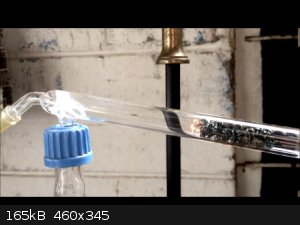
copper glows alright- just no discernable production of NO or NO2.
|
|
|
Jstuyfzand
Hazard to Others
  
Posts: 166
Registered: 16-1-2016
Location: Netherlands
Member Is Offline
Mood: Learning, Sorta.
|
|
The copper is too active, does this mean that the Ammonia gets converted to N2 and H2O immediately or does it go to NO first and then N2 and H2O?
If its the second, higher flow rates could take care of this problem, I presume.
|
|
|
Fulmen
International Hazard
    
Posts: 1716
Registered: 24-9-2005
Member Is Offline
Mood: Bored
|
|
Electrochemical urea to ammonia (eU2A) sounds like a promising alternative. The paper used nickel electrodes which had a catalytic function, luckily
nickel strip for battery assembly is easy to get hold of. The method used constant voltage; 1.65V applied to 30% urea + KOH.
We're not banging rocks together here. We know how to put a man back together.
|
|
|
Chemetix
Hazard to Others
  
Posts: 375
Registered: 23-9-2016
Location: Oztrayleeyah
Member Is Offline
Mood: Wavering between lucidity and madness
|
|
As to the question of whether the ammonia goes to NO then N2, it is largely academic. I can't say by observation alone. I'll leave that to analytical
chemists to solve one day.
But there just hasn't been enough time in the day for me to give the unit a good run down the highway so to speak, open her up and see what she can
do.
Holidays have consumed me with family duties and finishing off commercial work as well.
Why won't someone pay me to be a hobby chemist? Dammit!
So as yet I haven't been able to get an estimation of catalyst life expectancy. All I can say is the cobalt carbonate survived several shutdown and
restarts until a change in the system design ultimately caused it to die. Maybe using those clay balls was fine so long as there was moisture in the
stream to prevent the catalyst being poisoned somehow.
Maybe the ceramic tile fragments are cleaner and will run at higher temperatures and drier conditions and would have allowed the cobalt to survive
longer.
But I'm sure you can all appreciate that the goal is to find a set of parameters that allow the production of the highest volume with the highest
concentrations in the shortest amount of time. I'll get a few days soon to let it have a good run and get an estimation of efficiency and final
concentrations.
eU2A does sound like a faster way to get ammonia, but then, so is a bigger pot. The latter is the simpler approach, I'll leave electrochemistry for
those braver than me.
The gas bag idea sounds a great way to do analytical studies on the reaction. I have my chemical engineering hat on at the moment, it's all about
increase of production for minimum costs.
[Edited on 29-12-2016 by Chemetix]
|
|
|
| Pages:
1
2
3
4
..
6 |